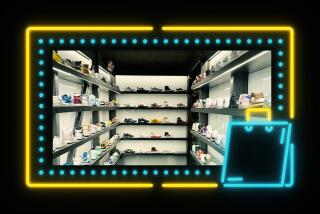Roller Derby : Small Stores Scramble for In-Line Skates
- Share via
Dave White is in the seemingly fortunate position of owning a skate shop in the middle of the biggest boom the in-line skate industry has ever seen.
But that blessing became a curse a few months ago when demand for the skates exploded and supplies dried up. In late spring, when White tried to order more Rollerblade skates--the most popular in-line brand--the company said it would not be filling any new orders until 1995.
“If I could be able to order skates and get them within a week or two, I could sell 10 to 20 pairs a week,” White said. “But now I can’t sell any. I don’t have what people are looking for.”
Instead, he is losing customers to sporting goods giants such as Oshman’s Sporting Goods, Sports Chalet and Big 5 Sporting Goods--chain stores that pre-ordered thousands of pairs of the skates and have continued to receive shipments while shelves in smaller stores stay empty.
“Big companies can afford to pre-order hundreds or even thousands of skates,” White said. “I’m a small shop, and I can only order two or three pairs at a time. Smaller skate shops have been shut out.”
Indeed, at Sportmart in West Los Angeles, the store is overflowing with in-line skates.
“We got too many (darn) Rollerblades,” said Tony Bell, an assistant manager. “We’ve been choking them up. Our buyers tend to buy and ship as many as they can.”
*
The discrepancy is the unintended consequence of a record sales year for in-line skate manufacturers, who woefully underestimated consumer demand for the 1994 season after coming off a relatively flat year.
“Demand is outstripping capacity between three and six months,” said Pierre Boivin, president of Canstar, which makes Bauer in-line skates. “It’s an industrywide problem.”
Although revenue climbed 13% to $243 million in 1993 from $215 million in 1992, the number of skates sold grew only about 4%, according to statistics from the National Sporting Goods Assn. in Mt. Prospect, Ill.
But things turned around quickly this year.
In the first quarter alone, 1.8 million pairs of skates were sold--nearly double the 1 million pairs sold in last year’s first quarter, said Henry Zuver, executive director of the International In-Line Skating Assn., a trade group in Atlanta.
Sales are expected to reach $325 million by the end of December, traditionally the biggest month for the industry, said Thomas Doyle, research director of the national sporting goods association.
“No one predicted that we would have this level of growth,” said Deborah Autrey, a spokeswoman for Rollerblade in Minneapolis, where extra shifts of workers are churning out skates as fast as they can. “There’s only so much capacity in our manufacturing facilities, and it just takes time to fill orders.”
Skate manufacturers and retailers are at a loss to explain the unexpected boom in skate sales, but many cite the introduction this spring of skates with more advanced braking systems that make it easier for skaters to stop. Other explanations include the proliferation of roller hockey leagues, the Winter Olympics--which featured athletes who train using in-line skates--and good weather.
Whatever the cause, specialty skate shops--which sell 15% of all in-line skates and often concentrate on stocking high-end blades for the skating connoisseur--are suffering.
“It’s costing me about 20 sales a day,” said Phyllis Fleschler, owner of Valley Skate & Surf in North Hills. “We’ve had lists of people (waiting to buy in-line skates). As a matter of fact, the oldest one on the list is from March.”
Unbelieving customers roam from store to store, often in a hopeless search for their first-choice pair of skates, said Patrick Lochouarn, owner of Venice Rollerworks.
“After going to six or seven stores, they realize” the skates aren’t available, he said.
Mark Pierre said he is asking around at hockey rinks and scouring the Trading Times in search of a new pair of in-line roller hockey skates.
In addition to being unable to place orders, stores report that they are not receiving full shipment on their pre-ordered skates. Shipments to Fleschler’s store have been down 25% since the shortage began.
Lochouarn got only a third of the Rollerblades he ordered in his August shipment and has scratched off his booking orders skates he is sure will not be delivered.
*
“I’m glad I’m not a small specialty store,” said Ric Miranda, a buyer for Sandy’s Ski & Sport, a three-store chain that has seen sales of in-line skates grow from a quarter to half its business in one year.
“It’s a Catch-22 for the little guy, because once the big company makes a big commitment, the little guy doesn’t have a chance to go back and order more,” Miranda said. “But they can’t cancel orders,” so they have to buy conservatively, he added.
But that, said Zuver of the in-line skate association, is “just business.”
“If you’ve got a chain store buying 100,000 units and a small store buying 100 units, the large store is certainly going to have more flexibility,” Zuver said. Still, he added, “most skate companies have been in business long enough to know that specialty shops are very important to them, and they don’t want to step on their toes either.”
On a Roll The number of in-line rollerskaters has increased fourfold since 1990...
Source: National Sporting Goods Assn.
More to Read
Inside the business of entertainment
The Wide Shot brings you news, analysis and insights on everything from streaming wars to production — and what it all means for the future.
You may occasionally receive promotional content from the Los Angeles Times.











